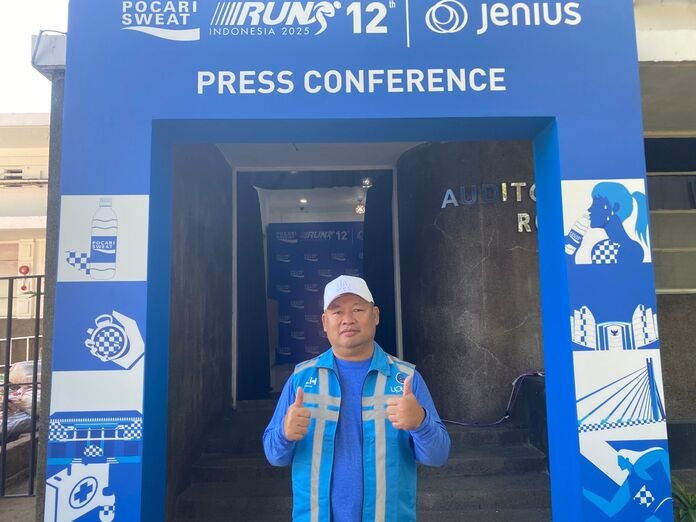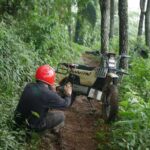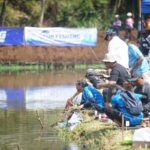The Bandung City Environmental Agency (DLH) deployed a special cleaning team to maintain urban cleanliness during the Pocari Sweat Run Indonesia 2025 event. The team immediately swept and cleaned the race route right after the last runner passed, particularly in waste-prone areas like water stations.
The Head of DLH stated that the agency focused on anticipating lightweight waste such as cartons, plastic cups, and drink bottles. He mentioned that the waste generated was significant in volume but not in tonnage.
“The collected waste is mostly lightweight, so we measure it by volume. Using tons as a unit isn’t very relevant for this type of waste,” he said at Bandung City Hall.
He revealed that DLH also collaborated with the environmental community Ingram to strengthen waste management during the event. This partnership proved effective in speeding up the cleaning process and maintaining urban cleanliness.
“We partnered with a community that is genuinely concerned about waste issues. They’ve proven to be responsive and quick in the field,” he explained.
The joint team mapped three high-risk waste accumulation points: the Ahmad Yani to Kiaracondong stretch, from the Jakarta Flyover to Kircon Road; the Grand Mosque to ABC Viaduct area, which was the main crowd center and participant route; and the Cicendo to Padjadjaran Road Kina Factory route, which, though relatively light, remained under supervision as part of the final race path.
To ensure cleaning efficiency, DLH mobilized waste transport fleets and stationed personnel at strategic points from early morning until the event concluded. These efforts were part of an integrated operational scheme involving the Transportation Department, Water Resources Agency, and Public Works.
“We ensure our fleet and personnel keep moving. This reflects our commitment to keeping Bandung clean during the event,” he emphasized.
He also urged participants and the public to avoid littering. DLH hoped the waste management approach successfully applied to the 5K and 10K categories could be optimized for the half marathon (21K) the following day.
“Today’s handling went well. We’re confident the same method can be applied for the 21K. But public participation remains key,” he concluded.
Bandung City Hall
Bandung City Hall, located in the heart of Bandung, Indonesia, is a historic colonial-era building constructed in the 1920s during Dutch rule. Designed in the Art Deco style, it served as the administrative center for the city and remains a symbol of Bandung’s heritage. Today, it functions as the mayor’s office and a cultural landmark, reflecting the city’s blend of colonial history and modern governance.
Ahmad Yani
Ahmad Yani is a major road and district in Semarang, Central Java, Indonesia, named after General Ahmad Yani, a national hero who was a key figure in Indonesia’s struggle for independence and later served as the Army Chief of Staff. The area is known for its commercial and transportation significance, housing markets, offices, and landmarks like the Ahmad Yani International Airport. General Yani was a prominent military leader assassinated during the 1965 coup attempt, and the site honors his legacy in Indonesian history.
Kiaracondong
Kiaracondong is a district located in Bandung, West Java, Indonesia, known for its bustling commercial and residential areas. Historically, it was a key transportation hub due to its railway station, which was established during the Dutch colonial era. Today, Kiaracondong remains a vibrant part of Bandung, blending historical significance with modern urban life.
Jakarta Flyover
The **Jakarta Flyover** is a network of elevated roads in Jakarta, Indonesia, designed to ease traffic congestion in the bustling capital. Constructed in phases since the late 1980s, these flyovers connect major areas like Tanjung Priok, Pluit, and Casablanca, improving urban mobility. They reflect Jakarta’s rapid urbanization and ongoing efforts to modernize its infrastructure amid growing transportation challenges.
Kircon Road
Kircon Road is a notable street in Pune, India, historically associated with the Khadki Cantonment area and British colonial influence. It is named after the *Kirki* (or Kirkee) village, which was a significant site during the Third Anglo-Maratha War (1817). Today, the road is known for its mix of colonial-era architecture, military establishments, and urban development.
Grand Mosque
The **Grand Mosque** (often referring to the **Masjid al-Haram** in Mecca, Saudi Arabia) is the largest mosque in the world and Islam’s holiest site. It surrounds the **Kaaba**, the sacred cubic structure believed to have been built by Prophet Abraham and his son Ishmael, and is a focal point for Muslim prayer and the annual Hajj pilgrimage. The mosque has undergone numerous expansions throughout history, with modern developments accommodating millions of worshippers.
(If referring to another Grand Mosque, such as the **Sheikh Zayed Grand Mosque** in Abu Dhabi, adjust details accordingly.)
ABC Viaduct
The **ABC Viaduct** is a historic railway bridge located in [insert location if known], known for its architectural significance and role in early 20th-century transportation. Built in [year if available], it served as a critical link for rail networks, showcasing engineering advancements of its time. Today, it may be preserved as a cultural landmark or repurposed for modern use, reflecting its enduring legacy.
*(Note: If you have a specific ABC Viaduct in mind, providing details like its location or era would allow for a more precise summary.)*
Cicendo
Cicendo is a district in Bandung, Indonesia, known for its historical significance and cultural landmarks. It was home to the Cicendo Hospital, established during the Dutch colonial era in the early 20th century, which remains an important healthcare facility today. The area also features educational institutions and traditional Sundanese influences, reflecting Bandung’s blend of colonial and local heritage.






